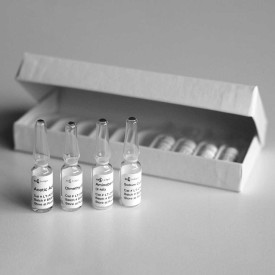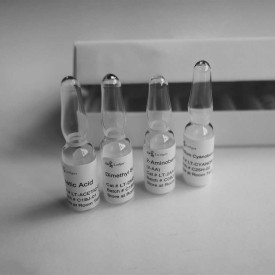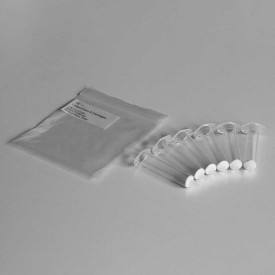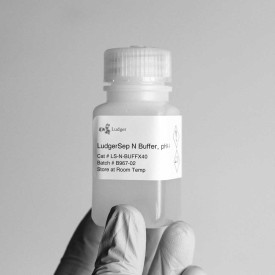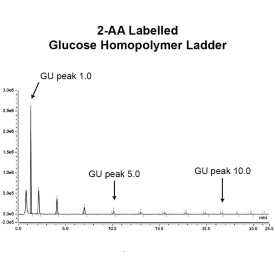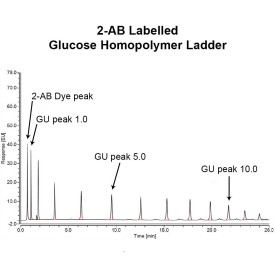LudgerSep N2 amide HPLC Column
Analysis and purification by HPLC of LudgerTag fluorophore and UV-chromophore labelled glycans. LudgerSep™ N2 HPLC columns contain particles with a polymeric amide coating optimized for high-resolution chromatography of complex glycan mixtures.
Product specification
Application: Analysis and purification by HPLC of LudgerTag™ fluorophore and UV-chromophore labeled glycans. The 2mm diameter column is recommended for LC-MS applications
Description: LudgerSep™ N2 HPLC columns contain particles with a polymeric amide coating optimized for high resolution chromatography of complex glycan mixtures.
Particles: 3 µm particle size with 80 angstrom pores and polymeric amide coating.
Column size:
| Cat # | Description | Dimensions |
|---|---|---|
| LS-N2-4.6x150 | LudgerSep N2 HPLC Column | 4.6 x 150 mm |
| LS-N2-2.0x150 | LudgerSep N2 HPLC Column | 2.0 x 150 mm |
Flow Rates: Typical flow rates = 0.4 - 1.0 ml/min for 4.6mm column = 0.15 - 0.22ml/min for 2.0mm column
Column Pressure: Maximum pressure = 2250 psi (150 kg/cm2) for 4.6mm column = 2900 psi (195 kg/cm2) for 2.0mm column
pH Range: 2.0 - 7.5
Temperature:Typical operating temperature = 30 oC. Temperature range = 10 - 40 oC.
Solvents: Typical solvent systems for glycan analysis include gradients of acetonitrile and aqueous buffers containing ammonium formate, pH 4.4. The recommended buffer is 50 mM ammonium formate pH 4.4 which is available in 50 ml aliquots for making up 2 liters: (Ludger catalog # : LS-N-BUFFX40)
Shipping Solvent: 75% acetonitrile - 25% water
Storage: For long-term storage, the column should be washed with a gradient going from the operational buffer to 100% water then to the storage solvent of >50% acetonitrile in water (v/v).
Column Protection: Filter all solvents to 0.2 µm and degas using either helium sparging or vacuum degassing. Filter all samples using a 0.2 µm filter membrane before loading onto the column. Install an in-line filter between the sample injector and the column.
Amount of Sample: The maximum amount of glycan sample that can be loaded on the column depends on the number and type of glycan components as well as the nature of any non-glycan material. The typical range for successful analytical runs is 10fmol - 1 nmol per sample peak and up to 200 nmol of total glycans.
Suitable Sample: Suitable samples include glycans labeled with the following LudgerTag™ labels : 2-AA (2-aminobenzoic acid), 2-AB (2-aminobenzamide), AA-Ac (3-(acetylamino)-6-aminoacridine
Sample Preparation: Filter samples to 0.2 µm then dry using a centrifugal evaporator. For the 4.6mm column inject the sample in up to 100 µl of the starting buffer (i.e. the solvent mixture used at the very start of the HPLC gradient). For the 2mm column inject the sample in up to 25 µl of the starting buffer (i.e. the solvent mixture used at the very start of the HPLC gradient)
Sample Detection: Either fluorescence, mass spectrometry or UV-absorbance depending on the dye used (see the appropriate LudgerTag™ instruction guide).
Handling: Ensure that any glass, plasticware or solvents used are free of glycosidases and environmental carbohydrates. Use powder-free gloves for all sample handling procedures and avoid contamination with environmental carbohydrate.
Safety:Please read the Material Safety Data Sheets (MSDS's) for all chemicals used. All processes involving labeling reagents should be performed using appropriate personal safety protection - eyeglasses, chemically resistant gloves (e.g. nitrile), etc. - and where appropriate in a laboratory fume cupboard.
For research use only. Not for human or drug use
HPLC System Requirements
LudgerSep™ N2 columns can be used with an HPLC system capable of delivering accurate gradients at a flow rate of 0.3 to 1.0 ml/min for the 4.6 mm diameter column, or 50 to 300 µl/min for the 2mm diameter column. In general, systems which mix eluants at high pressure (after the pump head) have lower dead volumes and supply more accurate gradients that are appropriate at the flow rate needed for LudgerSep™ columns. For the 4.6mm column inject the sample in up to 100 µl of the starting buffer (i.e. the solvent mixture used at the very start of the HPLC gradient). For the 2mm column inject the sample in up to 25 µl of the starting buffer
A fluorescence detector is required with the following detection wavelengths:
| Fluorescence Label | λex (nm) |
λem (nm) |
|---|---|---|
| 2-AB [2-aminobenzamide] | 330 | 420 |
| 2-AA [2-aminobenzoic acid] | 330 | 420 |
| AA-Ac [3-(acetylamino)-6-aminoacridine] | 442 | 525 |
For optimal detection, use wide slit widths (e.g. 10 – 20 nm). Sub-picomole levels of 2-AB or 2-AA labelled glycans can be detected with good signal-to-noise (depending on the sensitivity of the detector used).
To improve repeatability and intermediate precisions for glycan analyses use a column temperature controller. Good results can be obtained with a column temperature of 35oC.


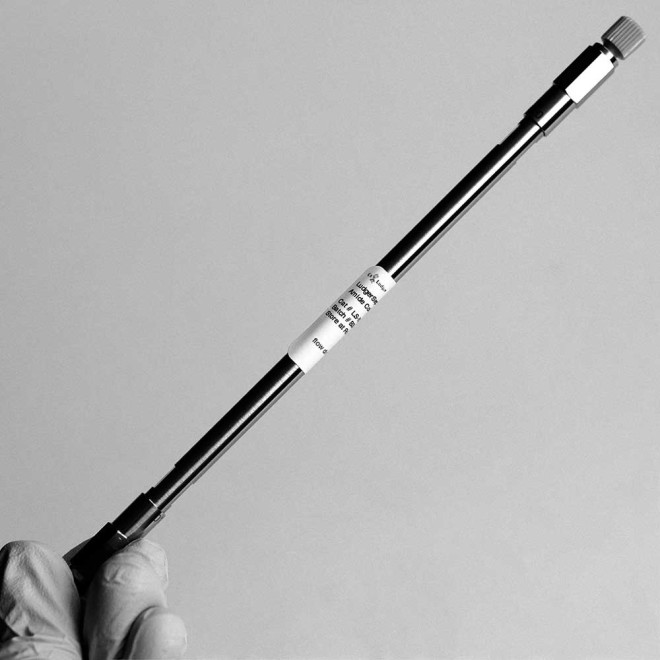
 Product guide
Product guide